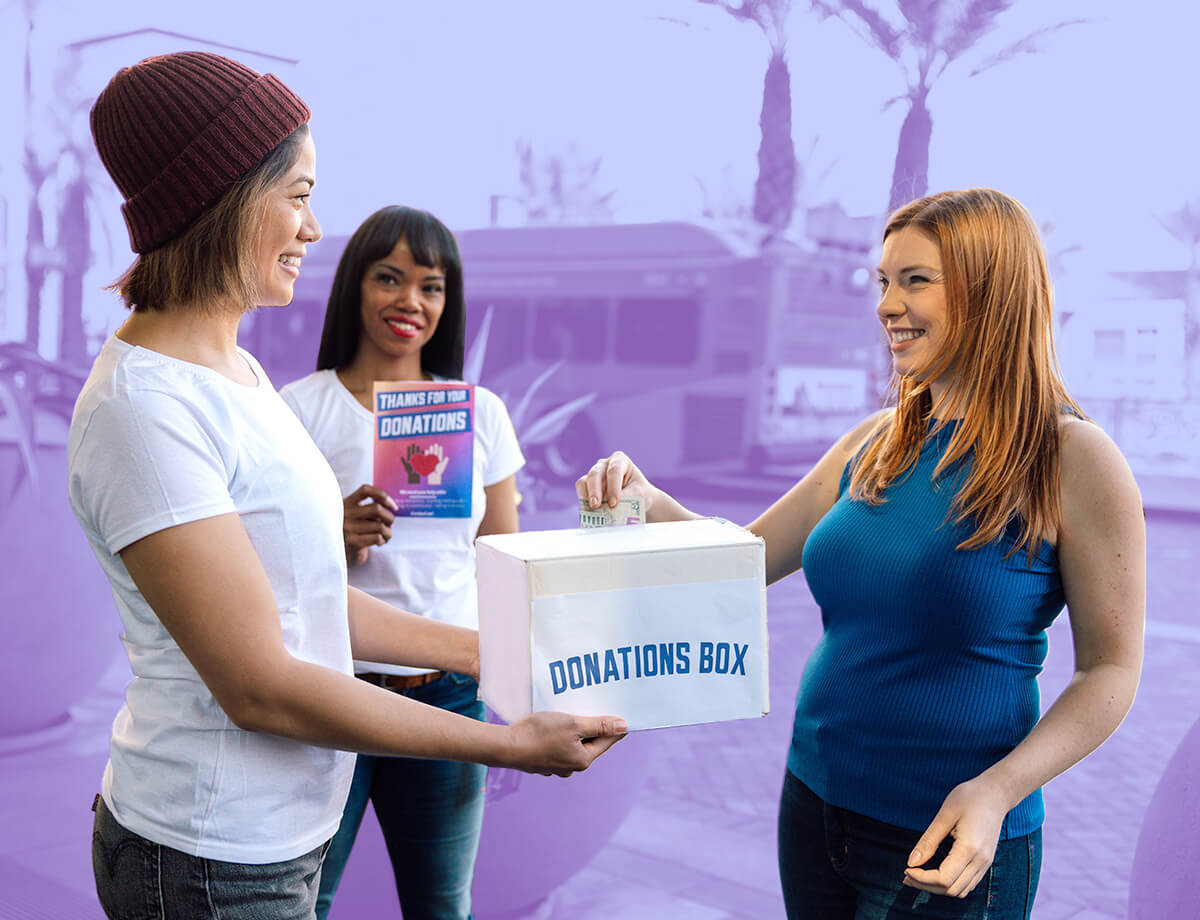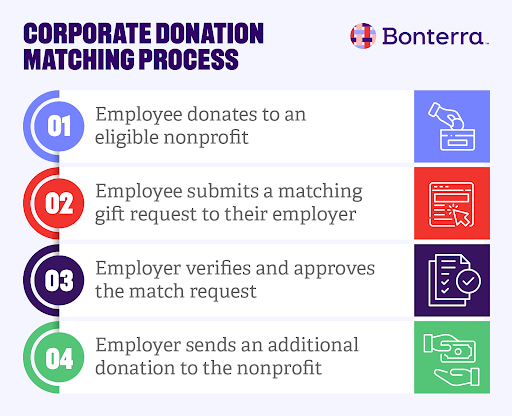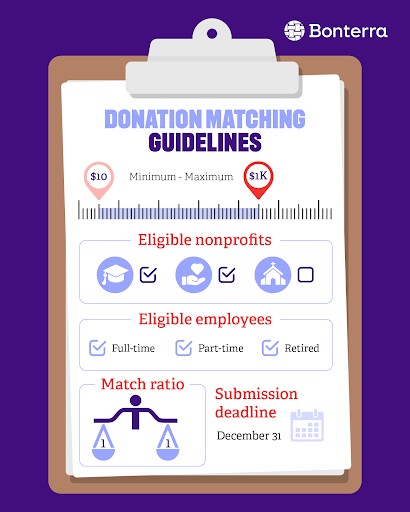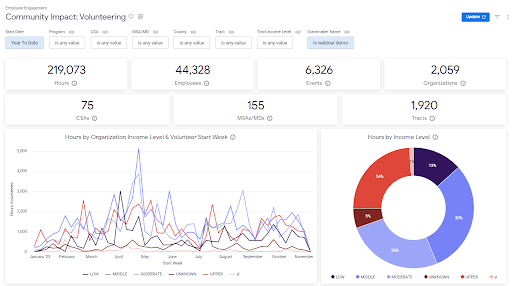Corporate matching gifts: Meaning, benefits, and employer program tips

Companies donate more than $2 billion through corporate matching gift programs as part of their corporate social responsibility (CSR) initiatives every year. For employers, this type of CSR represents an opportunity for community impact and a major driver of employee engagement.
Gift or donation matching is one of the most effective employee giving tools, amplifying employee donations, improving your company’s brand, and providing measurable CSR outcomes.
Corporations everywhere have seen the benefits firsthand and continue to prioritize driving impact by matching their employees’ donations to worthwhile causes.
If you’re not already familiar with the basics and benefits of corporate donation matching, this guide will cover everything you need to know about gift matching, including how to start your own program inspired by successful, real-life examples.
What is donation matching?
Matching gifts, or donation matching, is a type of corporate philanthropy program in which companies financially match their employees’ donations to nonprofit organizations, typically at a 1:1 ratio. Donation matching is one of the most common and impactful forms of corporate philanthropy.
It’s more than a CSR program — donation matching is a strategic philanthropy initiative that drives real change. Since donation matching involves both employees and corporations giving to worthwhile causes, it generates a clear, measurable impact while empowering team members to get more involved in philanthropy.
Why do companies match donations?
Donation matching programs are popular with companies across the country for a reason. Effective matching gift programs offer several benefits for your business, including:
- Increased social impact: Unlike traditional ESG initiatives that focus inward, donation matching helps your company generate real impact. Donating funds to vetted nonprofits and encouraging your employees to do the same multiplies your company’s impact on social good organizations.
- More engaged employees: Your employees want to work for a company that prioritizes social good, but they also want direct participation. Donation matching allows employees to take the lead by directing corporate funds to the causes they care about most.
- Improved employee retention: When your employees are engaged in philanthropy and believe in your company’s commitment to social good, they’re more likely to stay long-term.
- Reputation boosts: Customers and clients want to buy from socially responsible companies. Publishing impact reports can promote your commitment to doing good and improve your company’s reputation.
- Potential for long-term partnerships: Donation matching programs can introduce your company to relevant organizations, opening the door for mutually beneficial partnerships in the future. Once you find a nonprofit that aligns with your company’s values, you can support them with a sponsorship, grant, or custom-matching gift program.
Along with offering these benefits for your company, donation matching is a type of corporate philanthropy that benefits your organization, its beneficiaries, and your employees. Nonprofits get necessary funding while your employees get to increase their personal impact and deepen relationships with the organizations they care about.

How does donation matching work?
Donation matching programs are employee-led CSR strategies, meaning that your employees always take the first step. They get to choose:
- Which nonprofits to give to (within your company’s restrictions)
- How much to give
- When they participate
Once an employee decides to give, the donation matching process works like this:
- Employee makes a donation: Your employee makes a donation on an eligible nonprofit’s donation page.
- Employee submits a matching gift request to their employer: Depending on the CSR software you use, employees may submit requests from your company portal, a donor portal within your CSR platform, or directly on nonprofits’ donation pages.
- Employer approves the match request: When you receive the request, your company verifies that the donation meets the program’s requirements, such as gift size and organization type.
- Company sends an additional donation to the nonprofit: Once verified, you’ll follow your company’s donation matching guidelines to send the appropriate amount directly to the nonprofit.
At the end of the process, the nonprofit your employee supports receives two gifts that it can use to pursue its purpose.
Alternative ways to match employee donations
Companies can also explore other types of donation matching based on their needs and employees’ preferences.
Donation matching programs can automate employee donation matching for gifts made directly into a system. They make things easier for the employee so that match dollars aren’t left on the table and can maximize your overall impact.
In addition to a traditional program, you might offer:
- Company-wide donation match challenges.
- Custom matching gift pledges for specific nonprofits.
- Fundraising matches through peer-to-peer fundraisers.
Through our Dollars for Doers program, Bonterra CyberGrants and other Bonterra products offer a more optimized solution — where company funds are used to match employees’ donation of service hours. Each program works similarly but includes additional restrictions, like a set time frame, maximum amount donated, or organization.
How to start corporate matching gift programs
Like any type of CSR initiative, launching a corporate gift matching program requires clear guidelines and alignment. Before rollout, your leadership team should define eligibility, budget, and processes to create a strong foundation for long-term employee engagement.

1. Determine eligible organizations
Decide which nonprofits will qualify for your company’s matching gift program. Many employers allow donations to any 501(c)(3), while others focus on specific categories such as educational institutions, research organizations, or community-based charities.
You can align eligible organizations with your company’s core values — such as supporting education, healthcare, or environmental groups — or allow more flexibility.
2. Identify eligible employees
Clarify which employees can participate in workplace giving. Some companies restrict matching to full-time staff, while others include part-time, contract, and retired team members. Broadening eligibility often increases participation rates and strengthens company culture.
3. Select your match ratio and maximum donations
Choose a match ratio that balances generosity with sustainability. Common options include:
| Match ratio | Explanation | Example ($50 donation) |
| 1:1 | Dollar for dollar | $50 donation becomes $100 total |
| 2:1 | Doubled donation amount | $50 donation becomes $150 total |
| 0.5:1 | 50 cents per dollar | $50 donation becomes $75 total |
4. Set minimum and maximum donations
Establish minimum and maximum donation thresholds for your donation matching program. For example, many companies set a $25 minimum and an annual cap of $1,000 — $10,000 per employee.
Research suggests that higher maximums boost employee participation, with maximums over $10,000 increasing engagement with donation matching programs by up to 40%.
5. Set submission deadlines
Choose a clear deadline for submitting matching gift requests. Most companies use the end of the fiscal or calendar year. Communicate deadlines consistently across internal channels to encourage timely participation.
6. Outline the corporate matching request process
Define how employees can request matching gifts. Manual methods (like forms or emails) can work for small teams, but CSR software streamlines the process, reducing admin burden while improving participation.
At a minimum, require employees to provide:
- Exact donation amount
- Recipient nonprofit name
- Date of contribution
- Donation receipt or nonprofit contact for verification
Most corporate giving software automates verification and ensures consistent tracking of every match.
7. Launch and promote your gift matching program
Prepare employees for launch by documenting your gift matching policy and sharing it in your handbook or employee portal to ensure visibility.
Promote your new corporate giving program with clear documentation that outlines eligibility, deadlines, and the request process. Drive early momentum with incentives like recognition programs or rewards for top participants.
8. Use corporate philanthropy software to track your company’s impact
Track and report on the impact of your matching gift program with a system that works for you. Define success metrics such as total dollars matched, number of employees participating, and nonprofits supported so you can accurately organize and analyze your impact.

Corporate philanthropy software can help you measure both your company’s social impact and employee engagement. Bonterra CyberGrants’s Insights solution offers pre-built dashboards and flexible reporting, allowing you to measure outcomes across donations, volunteer hours, and cause areas for a complete view of your company’s community impact.
Corporate matching examples from leading companies
As you craft your new donation matching program, take inspiration from leading matching gift companies and what they’re doing well. Each of the following businesses has used Bonterra to maximize their social impact, engage employees, and give more funds to worthwhile causes.
Sunbelt Rentals
With 22,000 employees across the US, Canada, and the U.K., Sunbelt Rentals turned to Bonterra CyberGrants to scale its CSR programs globally while keeping them locally relevant. Through initiatives like “Sunbelt Rentals Gives,” the company generated over $1 million in donations and logged more than 1,800 volunteer hours in the first half of 2025.
CVS Health
In 2022, CVS Health launched a special emergency response donation matching program to provide medical aid to Ukraine. The company created a dedicated Ukraine relief dashboard within Bonterra and called on employees to donate as soon as possible.
Within 24 hours, CVS Health provided over $50,000 in matched donations, totaling $100,000 in total funding for the American Red Cross.
Shipt

Shipt, a same-day delivery service, offers a holistic workplace giving program that encourages employees to donate and volunteer often. With Bonterra in place to measure the program’s community impact, Shipt achieved the following results:
- Over 600,000 pounds of food donated
- 1 million meals provided
- $1.3 million donated to community organizations
- 6 million community members served
Drive more impact and engagement with Bonterra’s donation matching tools
Donation matching programs are a highly impactful way to generate more impact and engage employees at the same time. With the right mindset and best-in-class software, your company can see results from your program in no time. Remember to continually evaluate your program and take employee feedback into account, and you’ll end up with a thriving donation matching program.
Streamline your gift matching, drive more impact, and keep your employees engaged with Bonterra CyberGrants.
FAQ
What does gift matching mean?
Gift matching, or donation matching, is when an employer matches their employees’ charitable contributions, multiplying the impact of the original donation.
A 1:1 match ratio is common, meaning a company will make an equal donation to a nonprofit. If an employee contributes $50, the employer will contribute an additional $50 for a total donation of $100.
What does 3 to 1 match mean?
A 3:1 donation match means that your employer will contribute an additional 300% of your donation. For example, if you donated $100, they would donate $300 for a total of $400.
What companies have donation matching?
Many large corporations offer donation matching programs, including Microsoft, Google, IBM, and Coca-Cola, as well as a growing number of mid-sized businesses.
How do companies decide which nonprofits to include in their matching policies?
Companies usually have a pre-approved list of eligible nonprofits based on IRS 501(c)(3) status or mission and core value alignment. Some businesses select organizations based on location to support local impact.
Work with Bonterra



